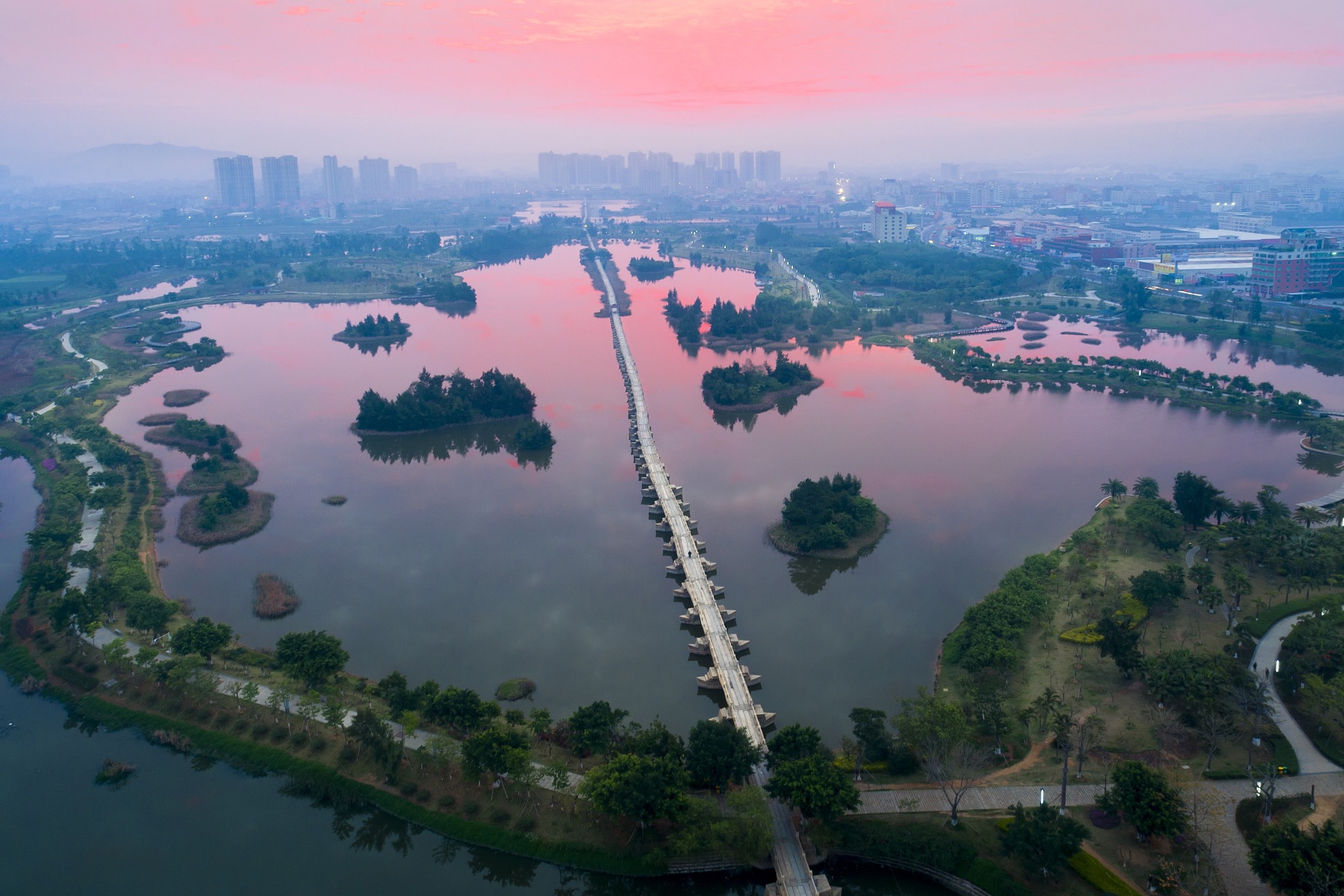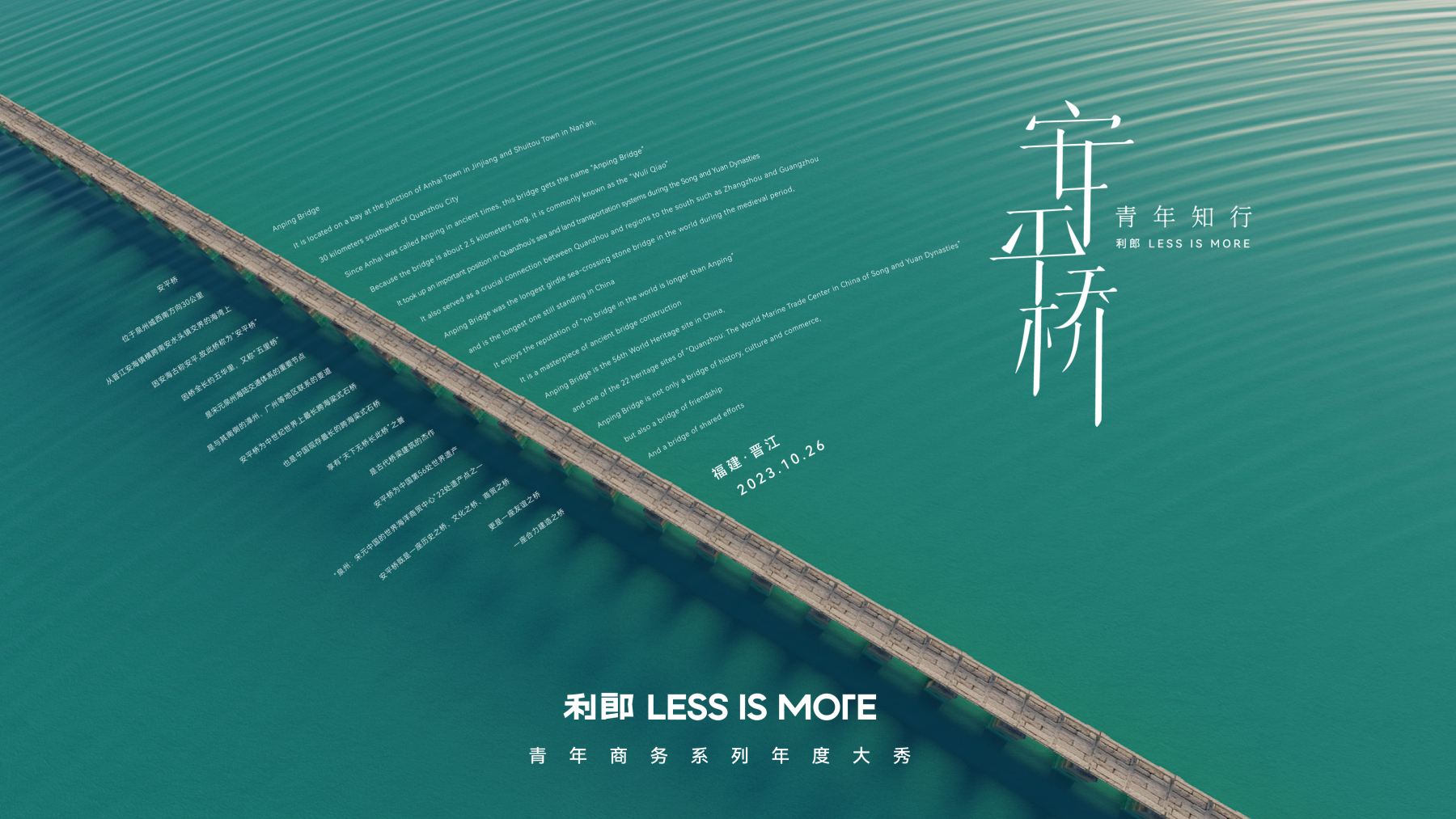On October 26th, at sunset, a contemporary men’s fashion show unfolded gracefully on an ancient stone bridge with a history of 885 years and a span of 2,255 meters.
This bridge is called Anping Bridge and is located in Quanzhou, Fujian, spanning the bay between Jinjiang Anhai and Nan’an Shuitou. There is a saying about this bridge: “There is no longer a bridge like this in the world.” It was initially built during the Southern Song Dynasty in 1138 AD. It is the longest existing ancient transoceanic stone bridge in China and was the longest sea-crossing stone bridge in the world during the medieval period. It played a significant role in connecting the Maritime Silk Road and is listed as one of the first national key cultural relics protection units, and in the UNESCO’s World Heritage List.
Born in Jinjiang, the Chinese men’s fashion brand LILANZ turned its focus to its hometown, contributing to the preservation of cultural relics and launching an annual fashion show for the youth business series. They use the language of modern aesthetics to celebrate the treasures in Chinese history and interpret “Genius Loci” of Quanzhou city.

Luxeplace.com had the privilege of participating in and witnessing the entire process of this extraordinary fashion show, from its planning to its execution. It provided a genuine experience of how Chinese brands draw inspiration from local culture and creatively contribute back to the community.
Why Anping Bridge? Why restore Anping Bridge?
In the early years of the Southern Song Dynasty, with the prosperity of overseas trade in Quanzhou, the transportation of goods in Anhai Harbor could no longer meet the growing demand, relying solely on ferries. In the eighth year of Shaoxing in the Southern Song Dynasty, Anhai merchant Huang Hu and Longshan Temple monk Zhiyuan each contributed a large sum of money to initiate the construction of Anping Bridge. In the twenty-first year of Shaoxing, the county governor Zhao Lingjin continued the construction, and it was completed the following year. The bridge runs from east to west, with a length of 811 zhang (approximately 2,255 meters) and a width of 1.6 zhang. It is paved with stone, supported by 361 piers, and has 362 arches over the water.
At that time, building a sea-crossing stone bridge was a massive project. Wu Jinpeng, the director of the Jinjiang Cultural Relics Protection Center, pointed out that the construction of Anping Bridge was the result of joint contributions and collaboration by members of the royal family, local officials, merchants, monks, and common people. It not only reflected the contribution of Quanzhou’s diverse social structure to maritime trade during the Song and Yuan periods but also demonstrated the economic prosperity and wealth accumulation brought to Quanzhou’s society by maritime trade.
It can be said that Anping Bridge was once a vital trade hub on the Maritime Silk Road and a bridge of history and commerce.
In 1961, Anping Bridge was listed as one of the first national key cultural relics protection units. In 2021, Quanzhou successfully applied for World Heritage status, becoming the 56th World Cultural Heritage site in China under the theme “Emporium of the World in Song-Yuan China”. Anping Bridge is one of the 22 representative historical sites among them.
Wang Junhong, the brand director of LILANZ, described it as follows: “Standing on the bridge for the first time, I had a feeling of time and space travel. Looking at the traces of stone paving on the entire bridge surface, it felt as if history was vividly unfolding before my eyes.”

The passage of time and the elements have left their marks on the 885-year-old Anping Bridge.
“Up to now, Anping Bridge has been repaired 18 times, some organized by official bodies and others funded by the public. It involves celebrities, wealthy merchants, and ordinary citizens,” Wu Jinpeng explained. The 14 stone tablets on the bridge record the history of various repairs to Anping Bridge and the names of donors, serving as historical evidence of Quanzhou’s diverse social structure supporting and participating in overseas trade since the Song and Yuan periods. It underwent several major repairs during the Ming and Qing dynasties, with the most recent one in the 1980s.
Facing current issues such as cracking of the bridge surface and subsidence of piers, the Jinjiang Cultural Relics Protection Center has prepared a restoration plan and is ready to start new restoration work this year. To support this effort, Jinjiang City established a cultural relics protection fund, and LILANZ was among the first to donate 2 million yuan. Regarding this initiative, Wang Junhong stated, “As a local brand, we have a responsibility to let more people see Anping Bridge and understand the importance of cultural relics protection.”
Wu praised this move, saying, “It’s a forward-thinking initiative that involves well-known local businesses to explore a new model for the activation and utilization of cultural heritage. It makes cultural relics protection more public and more social. Cultural relics protection has never been solely the responsibility of the state. We need to mobilize social forces to participate in cultural relics protection.”

For this fashion show, LILANZ collaborated closely with the Jinjiang Cultural Preservation Department. They thoroughly assessed the current state of Anping Bridge and, in a stable and safe manner, built a temporary floating platform seven meters from the bridge’s ends. This maximized the presentation of Anping Bridge’s original appearance while avoiding any impact on the bridge’s surface and foundation. In the twilight, modern people shared the same magnificent scenery as the ancients.
Minimalist aesthetics, a dialogue between the past and present. What inspiration does Anping Bridge bring to contemporary men’s fashion?
Anping Bridge embodies a simple and straightforward architectural style, spanning the bay in a straight line. The bridge surface is rustic, constructed using plain stone slabs. Each stone slab measures between 5-11 meters in length and weighs between 4.5 to 25 tons.
The bridge piers are meticulously built using intersecting granite stone blocks. Since the bridge crosses multiple harbor channels with varying depths and water flow rates, the designers took into account geological variations. They adapted the pier designs to suit different locations, including rectangular, single-pointed boat-shaped, and double-pointed boat-shaped piers, depending on the speed and direction of the tidal currents.

The aesthetics of Anping Bridge epitomize the refined craftsmanship and minimalist wisdom of the Song Dynasty.
Historian Chen Yinke once remarked, “The culture of the Chinese nation, evolving over thousands of years, reached its zenith during the Zhao and Song Dynasties.” The beauty of the Song Dynasty is characterized by simplicity, naturalness, gentleness, and elegance. This form of minimalism has influenced the world for nearly a millennium, from the plain-colored ceramics of the Song Ru kilns to Emperor Huizong’s slender gold script, and from the landscape paintings of Fan Kuan and Guo Xi. When viewed through modern eyes, it remains timeless. It serves as an inexhaustible source of inspiration for any artistic field.
For years, LILANZ has maintained its brand image and philosophy of “Simple Yet Refined” and “LESS IS MORE.” On Anping Bridge, LILANZ found resonance with the minimalist aesthetics deeply rooted in history. Their designs feature a predominantly white color palette with contrasting black outlines and harmonious shades of gray. The approach is minimalist and gentle, focusing on simplicity, solid colors, and texture to convey the artistic beauty of space and silence, which is the poetic expression of the Eastern realm.

Guest designer Xander Zhou explains the inspiration and concept behind the fashion designs for this show: On Anping Bridge, modern minimalism echoes the enduring simplicity of the Song Dynasty. The boxy silhouettes of trench coats, suits, jackets, and jumpsuits obsessively consider proportions, lines, surfaces, and structures. By striking a delicate balance between complex artistry and pure simplicity, they pay tribute to the creative exploration of “less is more” in new minimalism.
LILANZ’s youth business series combines formal elegance suitable for work environments with a casual sense of life, allowing young business professionals to dress comfortably for both commuting and leisure settings. Zhou notes that they are departing from extravagant and exaggerated silhouettes in favor of straightforward clothing items that prioritize functionality and serve the wearer.

“Journey and Return”: From Going Global to Returning to Hometown
In 1987, LILANZ started its journey in the men’s fashion manufacturing and wholesale business in Jinjiang, Quanzhou.
Quanzhou is the birthplace of Minnan culture and has a rich history of interaction and exchange between Chinese agricultural civilization and world maritime civilization. Holding a fashion show in the brand’s birthplace and headquarters is “a very meaningful event for us,” as Wang Junhong expressed.
During the Song and Yuan Dynasties, Quanzhou flourished in international trade and became the “Eastern First Port” where merchants from various countries converged, fostering cultural diversity. It was also recognized by UNESCO as the starting point of the ancient Maritime Silk Road.
Quanzhou’s silk production and trade thrived, and historical records describe Quanzhou as “the best in weaving and dyeing under heaven.” Even today, Quanzhou remains a base for China’s textile and clothing industry and a hub of Chinese fashion. It has produced leading Chinese brands and companies, including LILANZ.

Since 2002, LILANZ expanded beyond Fujian to national and international markets, attracting numerous design and creative talents from home and abroad. The brand has even graced the Milan Fashion Week. From going global to returning to their homeland, LILANZ continuously draws inspiration from the profound cultural heritage of their roots, enhancing their design capabilities and brand assets. Simultaneously, with the influence of the brand, they inject fresh vitality into the local culture, creating dazzling sparks.
In September of this year, LILANZ held the “Maritime Silk Road Art Season” in Jinjiang, featuring the “Code Play: The Path of Digital Fabrication” exhibition, where six international artists showcased digital art pieces, including a fashion show.
In October 2021, during Shanghai Fashion Week, LILANZ’s LESS IS MORE 2022 Spring/Summer collection paid tribute to Quanzhou by featuring the city’s splendor on the runway under the theme of “City of Light”.

Conclusion
LILANZ has consistently embodied the spirit of “simplicity” through practical means. This spirit isn’t about complex designs and concepts but rather the utilization of the brand’s accumulated organizational and creative strength over the years, making it easy for the target audience to choose the right products for themselves.
At the plain and rustic Anping Bridge by the azure shores of Anhai, we experience another interpretation of LILANZ’s spirit of “simplicity.”
The “simplicity” philosophy advocated by LILANZ has been passed down through millennia. Looking back, during one of the most splendid periods in Chinese history, the Song Dynasty, “simplicity” was already the main theme of aesthetic living.
Confucius had a saying, “A transmitter and not a maker.” The wisdom of our ancient sages has left behind a treasure trove, and there’s no need to artificially create “new” things when we can draw ample energy from exploring and interpreting the wisdom of our predecessors. On the path of rebranding, it’s not just about looking forward; it’s also about looking back. History will naturally inspire inspiration.
A brand’s DNA is closely related to the culture of its location; the brand’s spirit comes from a sense of belonging and pride in that place. Through the Anping Bridge fashion show, LILANZ brings this exquisite cultural heritage into the spotlight. They narrate the history treasures of Quanzhou in a genuine way, using contemporary fashion aesthetics, and share it with the world. This event also blends the brand’s confidence with the confidence in the local culture, uniting them as one.

|Image Credit: LILANZ LESS IS MORE, Quanzhou World Cultural Heritage List
|Editor: Xiaoyue Zhao



